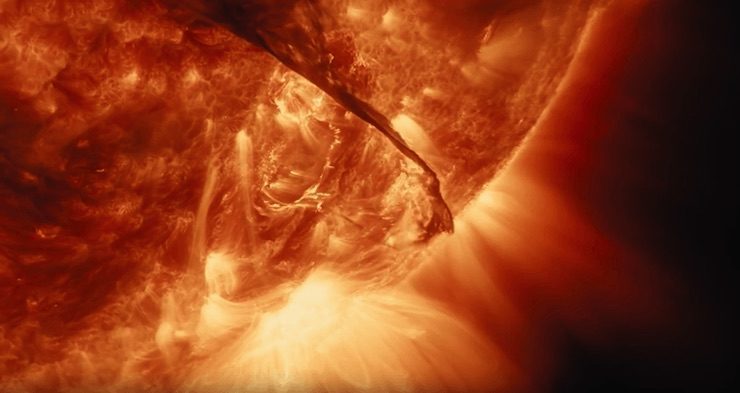October sees the arrival of Voyage of Time: The IMAX Experience in theaters as a 45-minute extravaganza from filmmaker Terrence Malick (The Thin Red Line), with a 90-minute standard-format edition narrated by Cate Blanchett releasing at a later date. This IMAX version has narration from Brad Pitt, who played the father in Malick’s Academy Award-nominated and Palme D’Or-winning The Tree of Life (2011).
Back when The Tree of Life unveiled, The New York Times hailed the film for having “produced the work at an IMAX level of detail, using 5.5K screen resolution.” Unfortunately, theaters never took advantage of this “crispness to their imagery” and the film was released only on standard screens. Not so with Voyage of Time, the companion piece to The Tree of Life—a nature documentary that is more than a documentary, Voyage of Time employs the most innovative special effects and most current science to reinvent the format. Its ambitious goal is nothing less than to recreate and chronicle the birth, life, and death of the universe and all that it contains.
In many ways, Voyage of Time is the fulfillment of an almost lifelong dream for Malick. He conceived this passion project back in the 1970s and intended it to follow 1978’s Days of Heaven. Over the course of decades, he collected film footage of natural landscapes and phenomena for this proposed feature, some of which ended up in The Tree of Life and Voyage of Time. It is in fact almost impossible to talk about Voyage of Time without discussing The Tree of Life, because large sections of what the filmmaker originally imagined found their way into both features, the two films near overlapping in their natural science and cosmological scenes.
From the start, Malick cast about for the best effects talent in the business to work on Voyage of Time. Preliminary pencil-and-ink drawings, found in Malick’s 1979 “Conceptual Notes and Drawings” for the project when it was called Q – short for Qasida; or, The Beginning of the World, “Qasida” being an ancient Arabian form of poetry – were done by special effects artist Richard Taylor II (Star Trek: The Motion Picture, Tron, Something Wicked This Way Comes). The color illustrations were the work of conceptual artist Ed Verreaux (the Back to the Future sequels, Indiana Jones and the Last Crusade). Taylor, in author Paul Maher Jr.’s definitive One Big Soul: An Oral History of Terrence Malick, also mentions “[h]uge production designers like David McCrone, who did Contact and many of Spielberg’s storyboards.”
The Q notes are littered with the names of special effects artists Malick envisioned recruiting. The sections marked “Age of Dinosaurs” and “Australopithecus” included Terry Carr and Rick Baker, both having worked on the 1976 King Kong remake. It is fascinating that a filmmaker known for his human drama kept so intimately acquainted with the world of genre movies. Going beyond entertainment in The Tree of Life and Voyage of Time, Malick stated in his notes his lofty aim “to create a sense of the glory of the universe, its fathomless harmony, its deeply tonic character.”
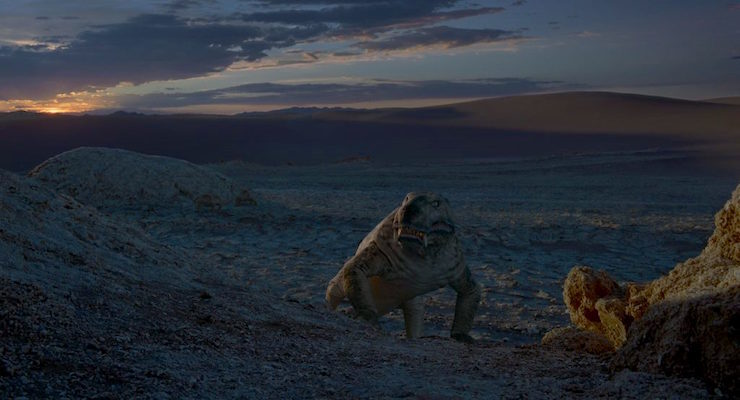
In Voyage of Time (as in Tree of Life), Malick brings to prehistoric life creatures such as the protomammal Gorgonopsid, the amphibian Diplocaulus, and dinosaur Muttaburrasauruses. Almost a dozen of the film’s many scientific advisers provided visualizations for these recreations, including paleontologist Dr. Jack Horner, Regents Professor of Paleontology at Montana State University and Curator of Paleontology at the Museum of the Rockies. While 2001: A Space Odyssey famously depicted a Dawn of Man sequence, The Tree of Life’s 145,000 B.C. scenes never made it past Mark Bristol’s storyboard stage; now Voyage of Time will, with its own Early Man chapter, fill that gap.
Sandwiched between these two epochs (the Age of Dinosaurs and Australopithecus) came a “birth of consciousness” segment that, according to fragmentary bullet points in the original notes, was to be “shot like horror movies (Forbidden Planet, Curse of the Cat People, where clues—sounds, trees falling, shadows, footprints, etc.).” A 3rd-8th Grade Educators Guide prepared as a supplement to Voyage of Time indicates that the documentary may grapple with consciousness by posing this post-viewing study question: “How did consciousness come into being? When did thoughts first form?” Voyage of Time viewers may yet see and hear the “sounds, trees falling, shadows, footprints” reminiscent of those made by the Monster from the Id in 1956’s iconic Forbidden Planet—in this case hinting at the invisible fingerprints and footprints of a mysterious Prime Mover who imbues that part of the mind from which comes, in the words of Leslie Nielsen’s Commander Adams of the United Planets Cruiser C57D, “laws and religion” because deep down “[w]e’re all part monsters in our subconscious.” After all, consciousness has, to this day, truly stumped many in the field of evolutionary biology. The screenplay draft for The Tree of Life touches on this key stage of life with the line, “Is not love, too, a work of the creation? What should we have been without it? How had things been then? Silent as a shadow, consciousness has slipped into the world.”
Twice in his early notes, Malick contemplated computer animation, a revolutionary notion for 1979 when Star Trek II: The Wrath of Khan and Tron—the latter with help from VFX supervisor/designer Taylor—were still three years away from being able to offer this kind of leap into the emerging technology. Anticipating today’s ongoing debate between CGI and practical effects, Malick in both instances mostly dismissed the idea of digital animation, preferring to entertain “UV-florescent material,” “the interface of two liquids,” and “furnace-fired models.” He cited “the way Trumbull created the clouds for Close Encounters,” 34 years before bringing Douglas Trumbull (2001, Blade Runner, Star Trek: The Motion Picture) aboard as visual effects consultant on The Tree of Life.
In The Tree of Life, Malick indulged and encouraged Trumbull’s experimentation to a generous degree, allowing him to, in Trumbull’s own words as recorded in One Big Soul, work “with chemicals, paint, fluorescent dyes, smoke, liquids, CO2, flares, spin dishes, fluid dynamics, lighting and high speed photography” and do “things like pour milk through a funnel into a narrow trough and shoot it with a high-speed camera and folded lens, lighting it carefully and using a frame rate that would give the right kind of flow characteristics to look cosmic, galactic, huge and epic.”
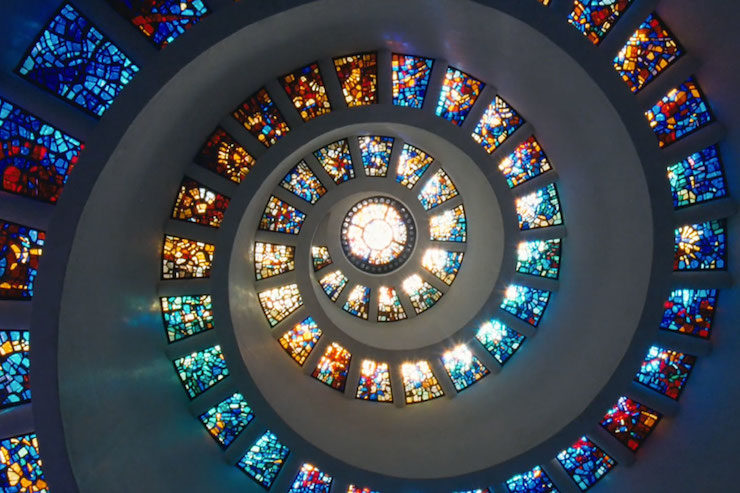
Though Trumbull, per the Tree of Life production notes, made the most of “Non-Computer Graphics” to achieve “something that’s completely organic,” the film nevertheless made concessions that resulted in “some truly amazing computer graphics,” estimating “[o]nly 10 to 20 percent of what you’re seeing is computer-generated, [and] you can’t tell which part of the frame is computer generated and which part is real which fits into Terry’s naturalistic world.” Senior visual effects supervisor Dan Glass (Batman Begins and the Matrix sequels), having worked in tandem with Trumbull on The Tree of Life, achieves this very same thing on Voyage of Time using everything from supercomputer visualizations to microphotography. With Trumbull currently immersed in other projects such as his “MAGI Pod theaters,” Glass flies solo on Voyage of Time and says, in that film’s production notes, that Malick and he continued “to see how various liquids, dyes, gasses and fluids might behave as we filmed them at high-speed. We used everything from gels and glass to smoke machines and fluid tanks to create a whole range of effects.”
Contributing concept art to The Tree of Life was George Hull (Amazing Spider-Man, The Lost World: Jurassic Park, Star Wars: Episode VIII) who shared his artwork at “The Tree of Life — George Hull Design.” Continuing that role in Voyage of Time, he stated on his Facebook page how he “was asked to paint concepts to help imagine the birth of the universe, black holes, etc … but with strict limitations on color spectrum, light quantity, and particles. All in effort to be scientifically accurate! Challenging but fun to do something different. I’ve always loved films like this since Baraka—epic visual poetry.”
“Below the Line: The Effects of The Tree of Life” quoted Glass as saying that “Terry was always trying to find the Tao, the beauty and natural aspects to the things he photographs.” An anonymous crewmember on The New World (2005) echoed this in One Big Soul, saying, “Most directors have editors working assembly line style, but Terry is all about experimentation and ‘finding the Tao.’ This is something he said on set and in post. ‘Film the Tao.’”
Many components from the Q notes found their way into The Tree of Life almost exactly as first conceived, beginning with “the primordial waters before the Creation, to that starless ocean where death dwells—a vast, immeasurable abyss, dark, wasteful, wild,” and then the Big Bang, the formation of our solar system, and all that came after upon ancestral Earth (bacterial, microbial, prehistoric life, etc.). The Tree of Life expands upon even Q’s ambitions, climaxing in glimpses of Earth’s end and the collapse of the sun into a white dwarf. Voyage of Time promises more of the same, only vastly expanded, up to and including the death of the universe itself (an event actually detailed in the Tree of Life screenplay).
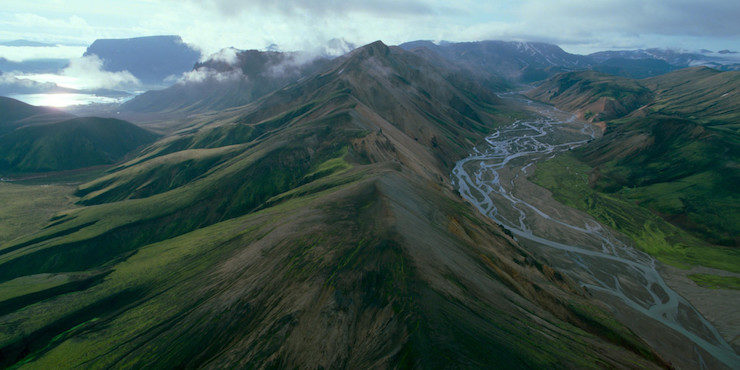
Even more esoteric elements made it into Tree of Life, such as when Malick visualized the “First Light (laser)…play[ing] by itself,” describing it as “light show.” This “first source” arrived on screen at several critical instances in The Tree of Life as “the lumia,” artist Thomas Wilfred’s undulating light sculpture. To represent this “light before the light,” Malick’s producers approached retired radio astronomer Eugene Epstein about filming one of the lumia compositions from his extensive Wilfred collection in order to “capture something about creation.” This light sculpture, standing in for the “[t]he fire of creation,” is seen by the authors Dan North, Bob Rehak, and Michael Duffy in Special Effects: New Histories, Theories, Contexts as a “handmade image” serving “as a rebuke to the perceived coldness and alienation wrought by the digital mediascape…”
The notes for this “First Light” demanded “music strong and triumphant, like ‘Hallelujah Chorus’” before the “first shot of cosmos.” Substitute a haunting Lacrimosa by Zbigniew Preisner (composer of many scores for the late Polish filmmaker Krzysztof Kieślowski) in place of George Frideric Handel’s majestic Messiah and you have the 22-minute Big Bang sequence of The Tree of Life, the “First Light” as First Cause, Preisner’s voices somberly imploring, “Pie Jesu Domine.” Like The Tree of Life, Voyage of Time virtually explodes in a Big Bang of classical music, much of it sacred compositions such as the Mass in B Minor by Johann Sebastian Bach, the Gloria by Francis Poulenc, Arvo Pärt chorales such as Te Deum and Da pacem Domine and, most appropriately, The Creation by Joseph Haydn. The overlay of abundant classical music coupled with astrophysical imagery will remind many of Trumbull’s 2001 scenes, though Malick has a different purpose in mind.
https://www.youtube.com/watch?v=9EEIeH7ymwA
A year after using Ken Middleham (Damnation Alley, The Mutations, The Hellstrom Chronicle) on Days of Heaven for time-lapse shots of seeds sprouting, Malick included his name as a possibility for further time-lapse photography involving “Atoms, Crystals … science photography” and “Ice Age Sights … Melting snow.” For a blue whale scene in the “Quaternary Wildlife” segment, he listed Al Giddings, a man with extensive National Geographic credits who eventually co-produced James Cameron’s Titanic and provided underwater photography for DeepStar Six and Cameron’s The Abyss. For “Quasars, Galaxies, Proto-Solar System” and other post-production effects, Malick adds to his list John Whitney, the man largely regarded as the father of computer graphics. Whitney’s pioneering work with slit-scan photography was early on adopted by Trumbull for 2001’s Star Gate effects, and not long after that he served on The Andromeda Strain as Trumbull’s uncredited video effects collaborator.
Paul Ryan (Batman Returns), Malick’s second-unit photographer on Days of Heaven, was tagged for the sections marked “Volcanoes—Infant Earth—Night,” “Geothermal Areas—Dawn,” “Atoms, Crystals,” “Supernova, Comet, Aurora,” “Devonian Forest,” and “Astrophotography, High Altitude Photography.” Most audaciously, Ryan was named for a more elaborate astrophotography section in which Malick envisaged that they “shoot what we can ourselves from space (high resolution video) or big telescope (35mm) —moon with earthshine, sun, Mars, Jupiter (time lapse)” and “reflect new astronomy, new vision of the world: 1. solar winds[,] 2. ripples moving through space[,] 3. the gray state between energy and matter[,] 4. new relations and connections between things.” New York Magazine writer Bilge Ebiri documents, in “Everything in Terrence Malick’s career has built toward The Tree of Life”, that it was Ryan, there when the project was new in Malick’s mind, who said, “Creation was the word that kept coming up, whether God’s creation or evolution.”
Time moved on from Malick’s 1979 notes, and of the plethora of names on his Q wish list, only Trumbull seems to have survived the cut, but with artists such as Glass, Hull, and so many others on board, the “awe, wonder and transcendence” of Voyage of Time is all but ensured.
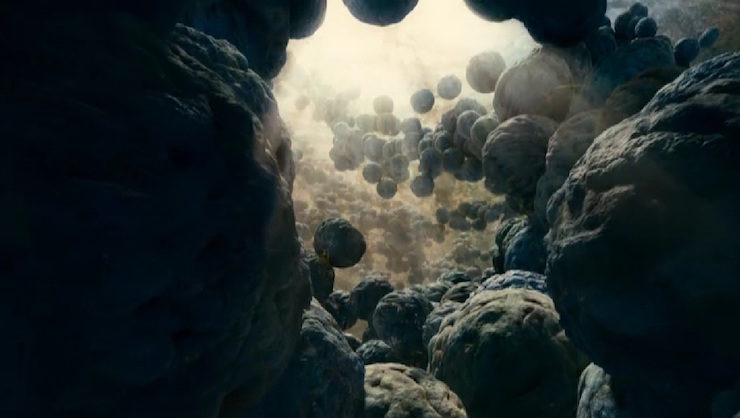
Voyage of Time is being promoted as a documentary event that, as the distributor reminds us, “examines all that went to prepare the miracle that stands before us now.” In marked contrast to Carl Sagan and Neil deGrasse Tyson, whose Cosmos documentaries lapse into scientism, the broader-minded Malick—whose past films quote and paraphrase liberally from the Book of Job, Søren Kierkegaard, Fyodor Dostoyevsky, and John Bunyan—thinks not in terms of science versus religion, but Nature and Grace: “Things opposite, bound together.” In his Tree of Life, this faith is explicit; in Voyage of Time it is implicit, but no less potent.
In Malick’s The Thin Red Line, Private Witt (Jim Caviezel) asks, “What’s keeping us from reaching out, touching the glory?” Now, Voyage of Time arrives at long last to give moviegoers a taste of what it is to, in the words of Malick’s own notes, “feel part of all this glory.”
Special thanks to Paul Maher Jr., author of One Big Soul: An Oral History of Terrence Malick, for much of the primary source material quoted in this article.
Gilbert Colon has written for Filmfax, Cinema Retro, Film.Music.Media, Crimespree Magazine, Crime Factory, The New York Review of Science Fiction, and several other publications. Additionally, he interviewed Tor editor Greg Cox and Tor.com contributor Matthew R. Bradley for SF Signal, as well as filmmaker Abel Ferrara for the Stark House Press book Invasion of the Body Snatchers: A Tribute. At present he is a contributor-at-large to Marvel University and bare•bones e-zine, both headed by former Scream Factory editor Pete Enfantino. Read him at Gilbert Street and send comments to [email protected].










